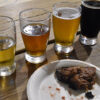Early Years: The How and The Why for Introducing Beef to Babies and Toddlers

As parents, nothing matters more than the health and safety of our kids. Did you know that within the first year of life, body weight triples, while length and brain size double (1,2,3)? Research shows that the nutrients our kids get their first 1,000 days of life (from pregnancy until their second birthdays) are critical for optimal growth and brain development (4,5). With protein, iron, zinc and choline, foods like beef can be an important first food that can be introduced around six months of age to help kids get a strong, healthy start!
The First 1,000 Days
The period from conception to a child’s second birthday is the most active period of neurological development compared to any other time in the lifespan (3,6). During this time, not only are calories important but specific nutrients, including iron, protein and zinc, are imperative for brain development (4,5). The best news is each of these brainy nutrients is deliciously available in beef!
Interestingly, the brain development that occurs during this period cannot be made up with nutrient repletion later (3). Missing key nutrients during this stage can have lifelong effects (3). While it may seem like our early eaters throw more food on the floor than they eat, we can make every bite count for health by preparing nutritious meals for the whole family.
When to Introduce Solids
Infants should be solely breastfed or fed an iron-fortified infant formula until about 6 months of age (4). For some children, the introduction of solid foods may begin as early as 4 months if the infant is developmentally ready (see chart below) or as recommended by your pediatrician (4). Introducing solids should not be delayed beyond six months (4).

*If you have any concerns about starting solids, consult with your pediatrician or health care provider.
Beginning with Beef
You may be surprised to learn that beef is a source of four of the six underconsumed nutrients of public health concern for older infants between the ages of 6 to 11 months (6). High quality protein, iron, zinc and choline found in beef support growing bodies, and healthy brain and nervous system development in babies and toddlers.

The American Academy of Pediatrics, and for the first time ever, the 2020 Dietary Guidelines for Americans outline nutrition recommendations from birth to 24 months. Having enough iron and zinc are both critical for immune function and brain development (4). In the US, about 77% of infants have inadequate iron intake and 54% have inadequate zinc intake (4, 5). By 6 months of age, breastfed infants require an external source of iron aside from human milk because iron content of breastmilk is inherently low and the infant’s nutritional requirements are increasing (4). Zinc content of breastmilk begins high and is well-absorbed, but the concentration declines over the first six months of lactation (4). Neither iron nor zinc content in breastmilk are dependent on the dietary intake of these nutrients by mom (4). Complementary feeding of solids helps make sure our kids receive the nutrients they need when they need them!
How to Safely Introduce Beef
To simplify meal preparation, cook beef how your family loves it. Then, offer it in age- and developmentally-appropriate textures for your children by pureeing it, serving it ground, finely chopped, in bite-sized pieces or in strips!

While store-bought, jarred beef baby food is an option, using the beef you already eat regularly as a family has advantages. Exposing your little eaters to the same flavors your family likes (yes, that even means some spice!) can encourage more adventurous eating and meal acceptance later in life. You also have the benefit of food modeling – showing your kids how you enjoy healthful meals, eating the same foods they are served. Serve beef alongside colorful fruits, vegetables and high fiber whole grains for balanced meals, one bite at a time.
Check out these great, soft recipes for early eaters:
Easy Homemade Beef Pasta Sauce
- Toss this beef pasta sauce over whole wheat penne noodles, which are conducive for palmer and pincer grasps.
- For infants: Chop, finely dice, or mash noodles if needed. Self-feeding infants can have whole noodles under close supervision.
- For toddlers: Serve whole soft noodles
- Can separate veggies, pasta and beef on high chair tray or toddler’s plate for better food acceptance. Ensure veggies are cooked tender
- For infants: Chop, finely dice, or mash beef, pasta noodles and veggies as needed. Cut off zucchini and yellow squash skin for early eaters if needed
- For toddlers: Serve as-is for advanced eaters
Lazy Day Beef & Vegetable Soup
- For infants: Reserve for older infants. Finely shred beef stew meat. Mash or chop veggies, pasta noodles and chickpeas if needed
- For toddlers: Dice or chop into smaller, bite-sized pieces
Slow-Cooked Mediterranean Braised Beef

- Remove dates from infant’s portion if needed. Serve alongside a soft fruit, veggie or whole grain
- For infants: Shred beef
- For toddlers: Chop into bite-sized pieces

- For infants: Gently mash with a fork or cut into strips
- For toddlers: Serve as-is
Mediterranean Beef Meatball Kabob

- For optimal meal acceptance, consider serving deconstructed on infant high chair tray and toddler plate.
- For infants: Mash meatball or chop in half and allow self-feeding under close supervision
- For toddlers: Cut meatball into bite-sized pieces
Many people enjoy beef, which makes it the perfect vehicle to offer more fruits, veggies and whole grains to your family.

Beef Fits the Bill
Make every little bite count by offering beef alongside fruits, veggies and whole grains for balanced meals and lifelong healthy eating habits! Beginning with beef can help ensure our kids get the nutrients they need, when they need them, for healthy growth and development.
References
- Sizer, Frances Sienkiewica, and Ellie Whitney. Nutrition Concepts and Controversies. Thompson Wadsworth, 2008.
- https://medlineplus.gov/ency/article/002005.htm
- https://www.ncbi.nlm.nih.gov/pmc/articles/PMC5987539/#:~:text=Overall%20growth%20of%20the%20brain,80%25%20of%20adult%20size3.
- https://pediatrics.aappublications.org/content/141/2/e20173716
- https://www.dietaryguidelines.gov/sites/default/files/2020-12/Dietary_Guidelines_for_Americans_2020-2025.pdf
- https://www.healthychildren.org/English/ages-stages/baby/Pages/Babys-First-1000-Days-AAP-Policy-Explained.aspx
- https://www.cdc.gov/nutrition/infantandtoddlernutrition/foods-and-drinks/choking-hazards.html







